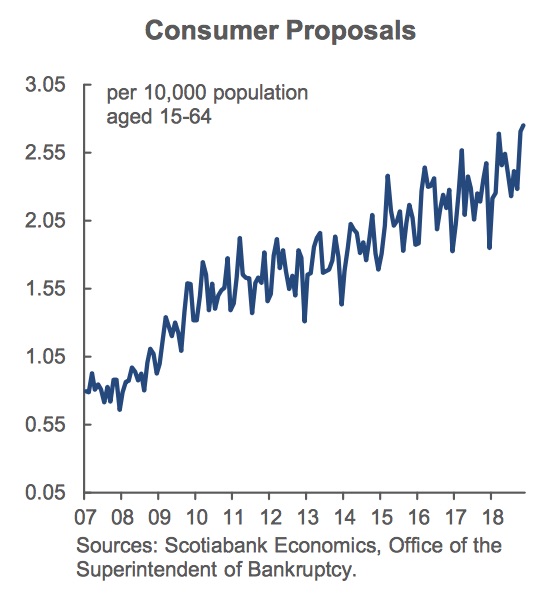An executive with one of the biggest Canadian banks is questioning the judgement of the Bank of Canada’s governor over his comments about bankruptcies in the country.
When Stephen Poloz announced this week that the central bank was maintaining the overnight rate at 1.75 percent, signalling mortgage rates should remain consistent for the time being, he noted bankruptcies are on the rise.
But that’s not the case, says Derek Holt, vice president of Scotiabank Economics, and it’s one of the things that differentiates our banking system from America’s.
“I don’t see consumer bankruptcies the same way as the Governor and was somewhat surprised by how the Governor is viewing bankruptcies given the importance of tracking how they are responding to higher rates and other developments,” writes Holt in a Scotia Flash report.
“Poloz says consumer bankruptcies have gone up. They have not,” he adds bluntly.

Recently, the Office of the Superintendent of Bankruptcy reported that consumer insolvencies were up 5.2 per cent in November on a year-over-year basis.
However, this measure is based on more than bankruptcies. It also includes proposals for restructuring debt (basically, a proposal for a repayment plan that may include asking a creditor for more time to pay off debt, or offering to pay a certain percentage of the total owed).
“Total insolvencies have risen because proposals have gone up, and they are a very different animal compared to going bankrupt,” Holt explains. “Bankruptcies are still toward record lows.”

In a separate note, Holt suggests the increase in proposals didn’t come out of nowhere. The impacts of rising interest rates and mortgage stress testing introduced a year ago are being felt.
“I would also contend that what we are seeing here is a reflection of one of the great relative strengths of the Canadian banking system versus, say, the US system,” writes Holt.
“Proposals are worked out through a willingness to restructure payments and debt without necessarily forcing the client into bankruptcy and seizing uncertain net asset values minus related costs.”








 Maziar Moini, Broker of Record - Home Leader Realty Inc.
300 Richmond St. W., #300, Toronto, ON M5V-1X2
Maziar Moini, Broker of Record - Home Leader Realty Inc.
300 Richmond St. W., #300, Toronto, ON M5V-1X2



